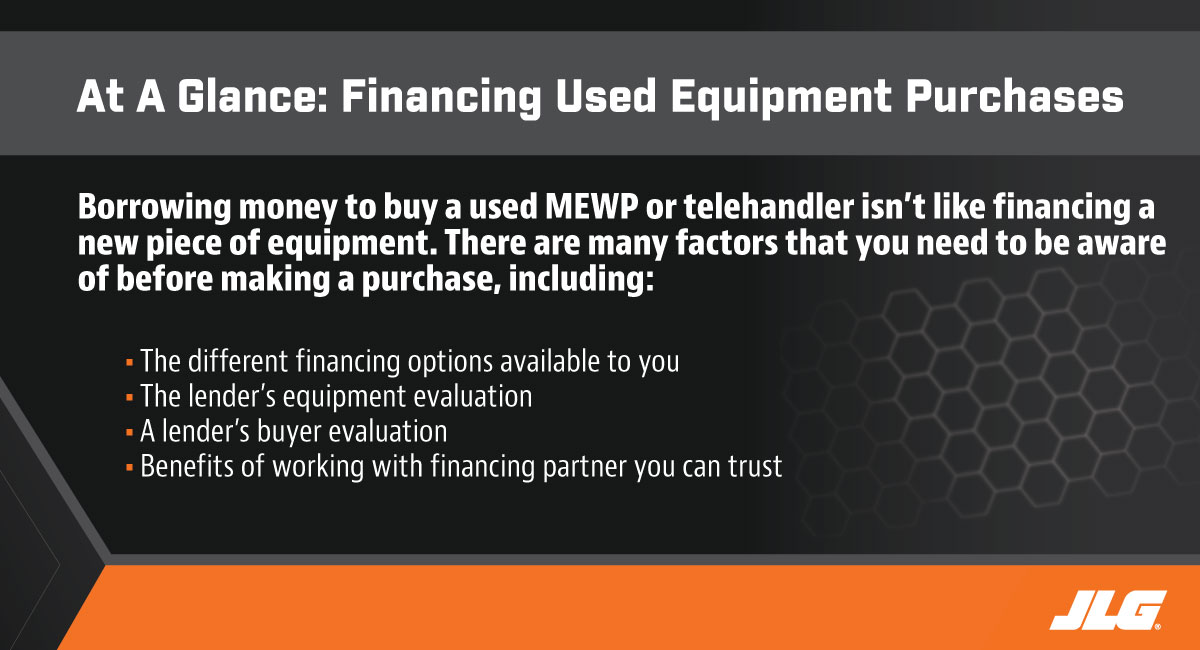 Matthew Coldsmith
Matthew Coldsmith
Sr. Director, Global Customer Financial Solutions
____
JLG Industries
The aerial industry is no stranger to weathering ups and downs in the construction economy, and many aerial equipment businesses have had to be more creative when it comes to making a dollar — it isn’t just about how to earn more money, it’s also about how to save more money.
When financing rates are low, and there is a healthy supply of used MEWPs (mobile elevating work platforms) and telehandlers on the market, adding used machines to an aerial equipment fleet may play a role in the money-making strategies of many construction and rental businesses.
But borrowing money to purchase a used MEWP or telehandler isn’t like financing a new piece of equipment. There are many factors that one needs to be aware of when looking at options to finance used equipment.

Available financing options
The three most common methods for financing equipment purchases are: Credit line, typical loan or lease. These options hold true for acquiring used equipment too, but, unlike with new equipment purchases, many used equipment sellers do not offer in-house financing. Many aerial OEMs, including JLG, offer competitive financing options for used equipment (similar to programs offered on a new machine), which often includes reconditioned machines. However, if you are purchasing from a rental store, an auction or a private or 3rd party seller, these types of programs may not be available.
This means that your business may have to look at different lenders to find the deal that best fits your needs — and, finding the lowest interest rate might not make the most long-term financial sense. With used equipment, it’s also important to look at prepayment charges, loan terms and the flexibility of the lender.
So, how do you know which financing program is best for your business? The first step is to know more about the pros and cons of the different options available.
1. A revolving line of credit is a great short-term option for businesses looking to put used equipment into their fleet now, then sell it within 12 months. The pro: There are no pre-payment penalties. The con: It is harder to get pre-approved if a business is not well established.
To get the best deal on a revolving line of credit, find out if any OEMs are offering specials on used equipment purchases, such as interest-free periods, or if they can help you set up the credit line with one of their trusted lenders.
2. Equipment loans for used equipment are based on fixed rates for repayment between 12 to 60 months. The product type, hours on the machine, the brand and the price will all be considered by the lender when determining the rates and loan terms available for the purchase. A general rule of thumb on the loan term is the 10-year “age + term” best practice. This is a scenario where the sum of the age of and term of the loan cannot exceed 10 years. The pros: Interest rates are low right now which translates to lower monthly payments. And, there are tax deprecation benefits. The cons: A down payment may be required (down payments usually range from 10-20 percent of the purchase price), used equipment interest rates are typically higher than new equipment, there may be pre-payment penalties and longer-term rates may only be offered on late-model rental-equipment purchases.
3. Leases for used equipment are very challenging, but some lenders will consider them. They are often based on terms specific to the length of a project or as long as a business needs the machine. The pros: Leases do not require a down payment, and your business will have the option to return the equipment, or purchase it, at the end of the lease. The cons: Lenders might not be willing to offer lease options on used equipment purchases, and if they do, there may be significant penalties or costs involved if you want to end the lease early.
With both equipment loans and leases, OEMs can also be a good go-to resource for getting the best financing deal. Although the OEM may not be the lender, they do offer services to help their customers, such as access to reputable funding partnerships, subsidized retail programs, customized plans, competitive interest rates and tailored payment plans. And, by going through an aerial OEM, you can take advantage of any special pricing or promotions that the OEM is offering.
4. For market conditions like those in 2020 and 2021, customized financing packages are also worth considering, especially for seasonal revenue and expense fluctuations, as well as business swings and situations that aren’t so predictable. Paying upfront for equipment and coming up with cash for ongoing/unplanned costs just adds complexity to a situation that’s already complicated enough. But, there’s help available if the equipment financing solution is flexible enough. For example, some financial services, like JLG® Financial™, may offer customizations that can give business a great deal of additional flexibility to manage the tricky balance between revenue and expenses. They may allow the buyer to finance 100 percent of the used equipment purchase, as well as up to 20 percent of soft costs associated with the purchase, something that is offered by very few standard bank loans and lines of credit.
Before securing financing, you will want to answer questions like how long will it take to pay back the loan, how much will it cost to borrow the money and how much money must be put down on the purchase. Knowing this information will help identify the best option for your business.
While you are considering the different financing options available to you, it is important to know that lenders will be considering their lending options for your business. This may include a thorough examination of the equipment, as well as your company, before they offer to fund your purchase.
Equipment evaluation
Before a lender will finance your used equipment purchase, they will want to evaluate the machine’s condition to make sure it’s a viable investment. Lenders will want to know the age of the equipment, what condition it’s in and who has previously owned it (bills of sale or proof of ownership from the original sale forward). And, unless each previous owner registered the machine with the OEM, buying used aerial equipment might require some detective work to make sure there’s a clear title to the machine and no liens against it.
Lenders will also research the machine’s fair market value. To do this, lenders will look at what similar machines go for at an auction or the average resale price. With this dollar figure in mind, a lender will then decide how much money they’re willing to lend for the equipment purchase. Unlike with new equipment purchases where the equipment is valued based on the OEMs retail price, with used equipment purchases buyers need to be aware that the price the seller is asking may not match the lender’s approved loan value for the machine.
Also, in general, lenders set higher interest rates for used equipment purchases than on new equipment purchases. This is because lenders perceive used equipment as more of a collateral risk because maintenance costs increase with age. This may also influence the lender’s approved loan value for the machine.
Buyer evaluation
Lenders will not only want to know what they are financing but who they are financing. To get financing, lenders will want to know your business’s credit history and references, which may include a review of your financial statements from multiple years, as well as to review your company’s past work history, documentation of current and ongoing projects, as well as be aware of any contracts for future work.
In addition to considering the value of the machine, lenders will structure financing programs, including interest rates, loan terms and payment options, with your company’s business information in mind.
Pick a financing partner you can trust
Financing used aerial equipment purchases can potentially be more challenging than financing new. That’s why it is important for you to work with a lending partner that has developed financing programs specifically designed to meet the needs of the access industry.
For example, in many cases, OEMs like JLG can offer flexible financing on used equipment purchases with convenience, as opposed to other lenders that flash low rates but have rigid terms and require a lot of paperwork to get approved. For instance, JLG Financial works with customers to minimize the upfront credit requirements while maximizing approvals. This practice allows businesses like yours to focus on profitability rather than attempting to secure a loan.
With the help of your lender, you can use your used equipment purchase to drive more profit, to help you manage fleet inventory more efficiently and to grow your business, even in the most uncertain of market conditions.
Want to learn more? If you are in the United States, visit JLG Financial by clicking here. If you are in Canada, visit JLG Financial by clicking here.
Want to stay up to date with industry news and trends similar to this? Make sure you subscribe below to receive monthly updates from Direct Access with newly posted content so you never miss important information.